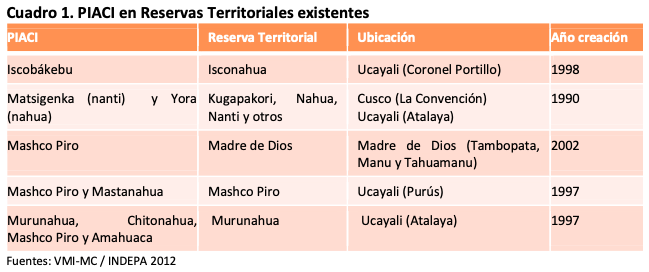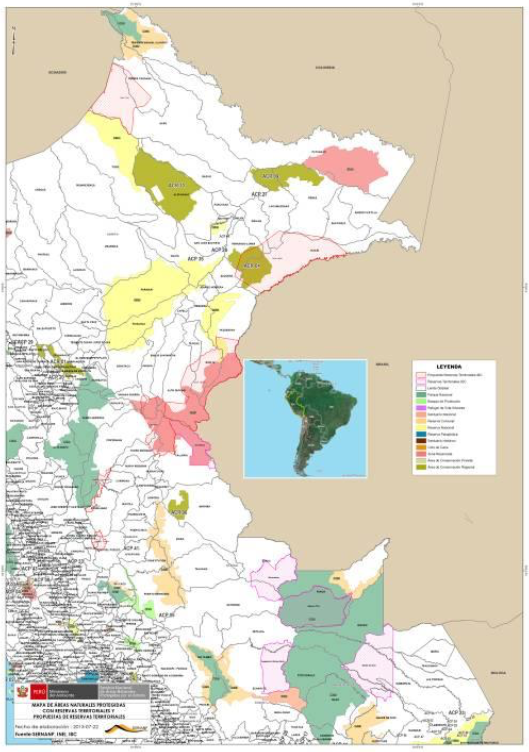
PIACI diagnosis
Preparation of the original document:
ALFREDO GARCIA ALTAMIRANO
National Facilitator Peru ACTO/IDB Program
2013
INDIGENOUS PEOPLES IN ISOLATION OR INITIAL CONTACT IN PERU
The isolated Amazonian indigenous peoples in initial contact in Peru are protected in formally created territorial reserves, in areas where protection proposals have already been formulated, and also in protected natural areas. Tables 1, 2 and 3 below break down the ethnic groups and location of land reserves – by type, as well as the year the settlements were created/identified.



MAPA INTERATIVO
Observe no mapa interativo do Módulo Povos Indígenas, onde se localizam os territórios indígenas na região amazônica e observe as regiões fronteiriças estudadas pelos consultores da OTCA:
VULNERABILITIES AND THREATS
In Peru, indigenous populations that are isolated or in initial contact are exposed to significant risks and threats, mainly due to access to land and the intensification of exploration for oil and other minerals, such as gold. In addition, there are crops of illicit substances that generate drug trafficking activities and bring violence to the regions.
The areas where they are located also face illegal logging and coexist with illegal hunting and fishing, as well as religious missions and archaeological exploration that end up affecting their lifestyle.
The land road projects that most affect the survival of the PIACI are those that propose the construction of a road between Puerto Esperanza (Ucayali) and Iñapari (Madre de Dios) in areas of permanent preservation and the Madre de Dios Territorial Reserve. Another sensitive road project is the connection between Cruzeiro do Sul (Brazil) and Pucallpa (Peru) that may affect protected areas, especially the Isconahua Territorial Reserve.
The Peruvian government has also awarded several exploration license contracts that directly affect the Kugapakori Nahua Nanti land reserve. Drug trafficking routes are also present in the Peruvian Amazon, on the border with Brazil and Bolivia, located between Ucayali and Madre de Dios, affecting the bordering territories of the State of Acre (Brazil) and the province of La Paz (Bolivia).
The Map shows the relative location of the existing RTs, proposed RTs and ANPs with PIACI in the Peruvian Amazon.

SYSTEMS OF HEALTH
The National Center for Intercultural Health (CENSI) is the normative technical body of the National Institute of Health and has among its main objectives the proposal of policies and regulations on issues of intercultural health of indigenous peoples and is part of the National Technical Committee of the ACTO Program /IDB for PIACI.
In 2004, the National Health Strategy for the Health of Indigenous Peoples was created, which included reference to the PIACI. In 2005, the Health component of the “Comprehensive Plan for the protection of peoples in voluntary isolation and initial contact of the Nahua-Kugapakori Reserve” was prepared.
In 2007, CENSI produced the following documents:
Sanitary Technical Standard: Prevention, contingency before contact and mitigation of health risks with the presence of indigenous people in isolation and in initial contact;
Technical Guide: Relationship for cases of interaction with indigenous people isolated or in recent contact;
Technical Guide: Health care for indigenous people in recent contact and in initial contact with a high risk of morbidity and mortality. All were approved in September 2007
These standards and technical guides define the Components (Prevention; Contact Contingencies; Risk Mitigation) and Responsibilities (National, Regional and Local) for their application by public health establishments.
CENSI also works with the permanent training of health personnel from the Regional Health Directorates, where the PIACIs are located. Official reports, however, indicate that the high turnover of health personnel limits the effectiveness of preventive measures and the application of Standards and Technical Guidelines.
